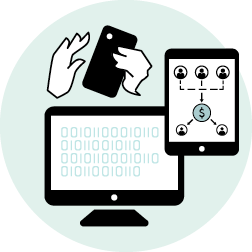Due to population growth and rising income levels, the U.S. professional services industry is expected to grow over the next few years. Freedonia Focus Reports forecasts personal expenditures on professional services to reach $600 billion in 2023, rising at a 2.9 percent rate from $521 billion in 2018. According to business investment facilitator, Select USA, the overall U.S. professional services market is worth approximately $2 trillion dollars.
While the professional services industry is growing in general—even during the global COVID-19 pandemic—it, along with other industries, is impacted by new technologies across different business areas like marketing, service delivery, operations, and more. Many of these new technologies are simple to adopt, and they can offer almost immediate efficiency improvements and opportunities to maximize customer retention and growth.
The Professional Services Market is More Competitive than Ever
Whether your business is in the individual market or the corporate market, professional services customers are changing. Are you keeping up? Check out the top five ways your customers are evolving in 2020 and beyond.
- Customers depend on the Internet for research, services, and pricing.
You should ensure that your website is informative by listing your business’s services, accomplishments, and pricing (if possible). If a potential customer can’t get the information they need from your website, they’ll find it somewhere else.
- Customers are more knowledgeable than ever.
Tax codes, legal codes, and more are available—whether online or otherwise—to your prospective customers. No doubt, the information gap between professional service firms and clients has been significantly narrowed. This means your website content needs to be meaningful rather than generic.
- Customers are driven by cost and pricing.
Corporate buyers in particular have become increasingly focused on value and transparency regarding costs. Consider also that prospective customers/clients will likely shop around before fully engaging the sales process. This means they’ll have deeper insights into the value of your services compared to your competition long before you win their business.
- Customers are looking for ease and convenience.
Across almost every industry, customers are fully engaged in omnichannel commerce. Customers expect the buying process to run the full gamut—from brick-and-mortar to website to social media—with the ability to purchase online. The bottom line is: the omnichannel model will only increase throughout 2021.
- Customers want fast results.
Today’s customers want results fast. If the information they’re searching for isn’t readily available, they’ll move on to the next provider. Remember, you should delight your customers with relevant information, valuable services, and value-added follow-up activity, including quick results.
The nature of competition in the professional services market continues to evolve. Technology is enabling new ways to deliver professional services. Firms are seeking new revenue streams and adding services that may have traditionally been in the purview of other professional services. For example, according to a consultants500.com blog post, traditional accounting firms are entering legal and consulting markets. And competitors are emerging from around the globe, with the opportunity to connect with clients anywhere regardless of their location.
The common denominator on both sides is technology. Websites offer search and payment capabilities and the ability for firms both old and new to provide services any time, any place. Artificial intelligence and machine learning allow services to be delivered in an entirely different way. For example, automating tax returns could free up accountants to engage in other work tasks and billable services. Thanks to the advantages technology can offer, professional services firms looking to be more efficient and price-competitive are exploring how new technologies can transform the way they operate.
Your Clients Are Online. Are You?
Even if your business isn’t quite ready to explore artificial intelligence or machine learning, it’s extremely important that professional services businesses are meeting clients and prospective clients wherever they’re shopping—in the store, online, and across social media channels.
- Evaluate your website and make sure it’s attractive, user-friendly, and fully operational. Broken links and glitchy functionality can make your business look unprofessional, which is the last thing you want when you’re offering services in a competitive environment.
- Take a look at your mobile presence, and tweak it to make it easier to navigate from a smartphone or tablet.
- Make sure your search function is configured correctly and is located in an obvious place on your website. Additionally, your site should be optimized for mobile use.
As for your payment and billing capabilities:
- Are they flexible? Do you offer payments across all channels: online, mobile, and in person?
- Are they secure, so you can simplify billing, safely store payment information and offer convenience to your customers?
- Can you update payment cards on file automatically so that recurring and returning customer transactions are approved seamlessly?
- Do you have access to payments experts and reports to consider cost-saving options and help inform decision-making?
Notice that an effective online presence and payment capabilities make interactions and operations more efficient for all parties involved. This helps drive growth, productivity, and profitability.
Though new technology can be intimidating, it also enables businesses to reinvent the way they do business. In that regard, technology can be the unlikely hero of your business.
Are you ready to start bringing Money INTM fast and easy? Learn more about our full-suite of payments acceptance products.




